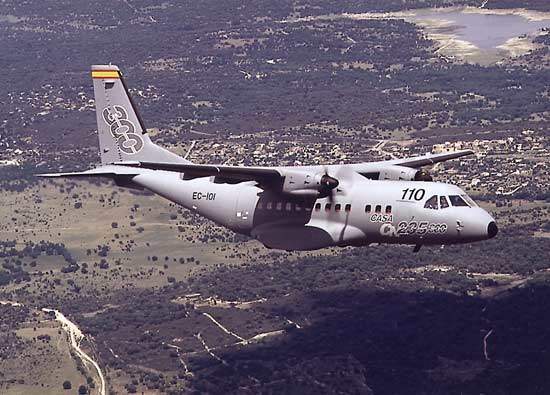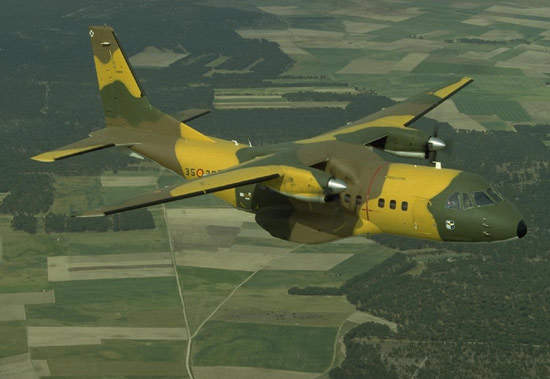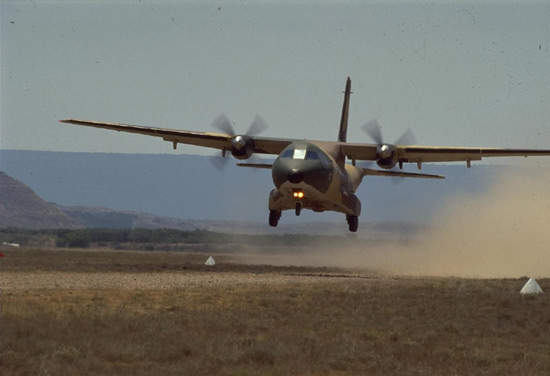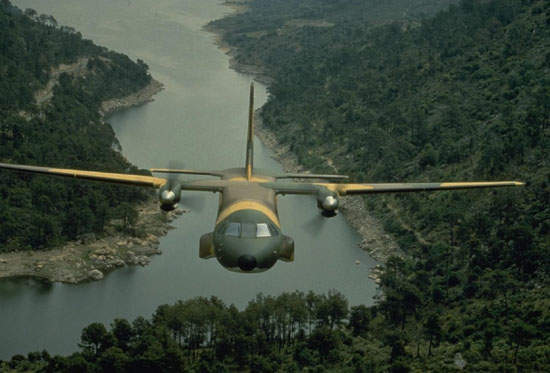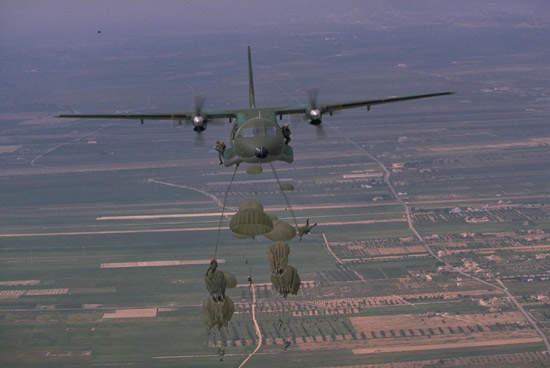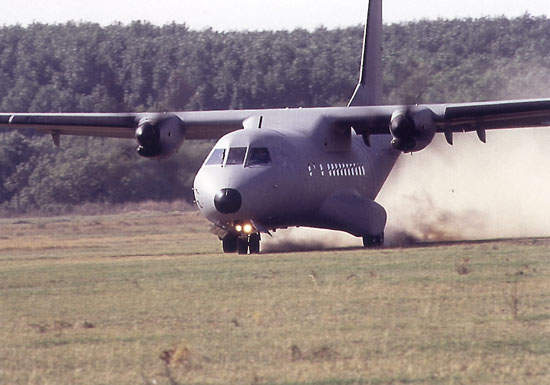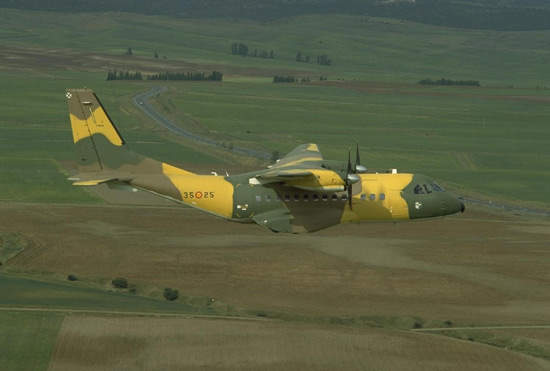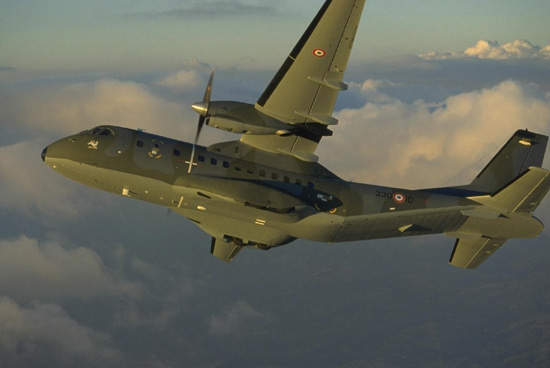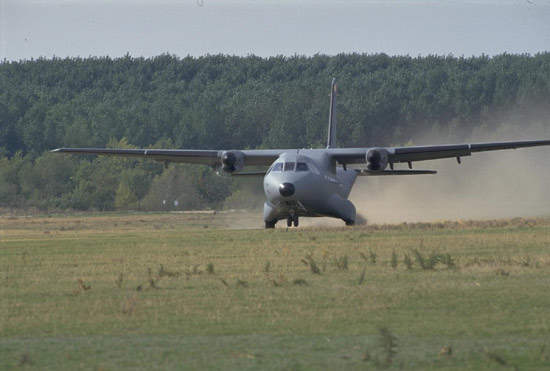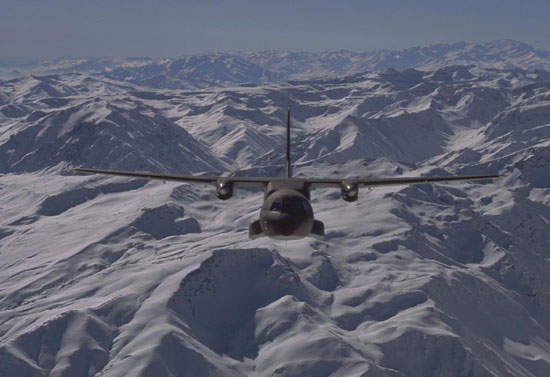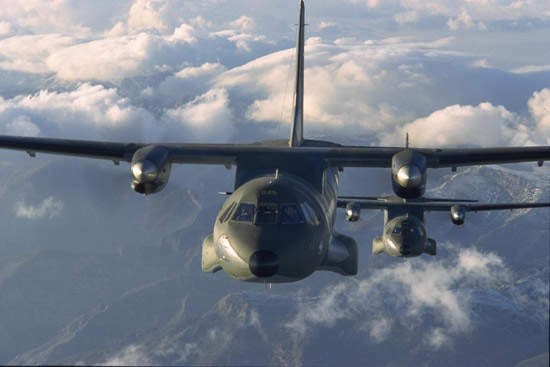EADS CASA, with headquarters in Madrid, has developed the CN235-300 multi-mission tactical transport aircraft in a number of special application versions including tactical transport, maritime patrol, electronic warfare (ESM / ECM and ELINT / COMINT), navigator training and aerial survey.
Over 272 CN-235 short take-off and landing transport aircraft have been produced; 230 are in service with over 20 countries worldwide, including the air forces of France, Spain, Turkey, Malaysia, Morocco, Columbia, Pakistan and Indonesia.
CN235-300 transport aircraft development
EADS CASA of Spain and Dirgantara Indonesia (Indonesian Aerospace), formerly IPTN of Indonesia, formed the company Aircraft Technology Industries, or AirTech, to develop the CN-235 aircraft. Project teams in Spain and Indonesia simultaneously began the design work in 1980 and organised simultaneous aircraft roll out ceremonies in 1983. The aircraft took for its maiden flight in November 1983. The production version of the aircraft first flew in August 1986 and entered service in March 1988.
EADS CASA developed a series of variants of the 235, with improved payload, performance and maintainability. The CASA family of 235 series aircraft have gained civil certification by the United States Federal Administration, the European Joint Aviation Authorities (JAA) and the Australian CAA Aviation Authority.
The new CASA CN235-300 provides improved hot and high performance, in-flight refuelling for extended range and longer time on station, higher-rated pressurisation and optional twin nosewheels to replace the single nosewheel for improved operation on short and unprepared runways. The take-off run is just 1,217m and the plane can transport loads up to 6,000kg.
The maritime patrol variant (CN-235-300M) was selected for the US Coast Guard’s Integrated Deepwater System in July 2002 and the prime contractor Lockheed Martin received a contract in February 2004 to deliver 36 aircraft.
The first 36 aircraft, designated HC-235A, was delivered to Lockheed Martin, for integration of the mission systems, in December 2006. Operational Evaluation began in 2007. All 36 aircraft are to be in service by 2017.
Orders and deliveries
The French Ministry of Defence awarded a $300m contract to EADS CASA in April 2010 to deliver eight CN-235-300 aircraft. Deliveries are expected to conclude in 2013.
Indonesian Air Force procured CN-235 maritime patrol aircraft in June 2008. It is fitted with the Seaspray 4000, the AN/APS-134 and the Ocean Master 100 radars.
Flight deck
The flight deck accommodates the pilot and co-pilot and a mission crew member.
The Series 300 CN-235 cockpit is night-vision-goggle compatible and fitted with twin head-up displays. The electronic flight and information system, a Rockwell Collins EFIS-85B (14), has four 152mm x 203mm (6in x 8in) liquid crystal displays.
The aircraft is equipped with an open-systems avionics suite with MIL-STD-1553B and ARINC 429 military digital databuses, a Thales (formerly Sextant) Avionics Topdeck colour weather, flight data recorder, cockpit voice recorder, advanced terrain collision avoidance system (enhanced TCAS) and Ground Proximity Warning System (GPWS).
Cabin configurations
The fully air conditioned and pressurised cabin can be configured for passenger transport, for mixed passenger and cargo or for all-cargo operations.
For passenger transport, the cabin can accommodate up to 44 passengers seated four abreast, 57 fully equipped troops or 48 paratroops. Paratroops can drop from two rear doors. In the medical evacuation role, the aircraft can transport 24 litters (stretcher patients) and four medical crew.
A roller loading system is fitted for easy loading of cargo and a wide ventral door and cargo ramp in the upswept rear fuselage. The cabin can carry up to four standard LD3 containers and is equipped for parachute load dropping. The aircraft is fitted with an in-flight operable rear ramp. Loads can be dropped using low altitude (LAPES) or high altitude delivery (HAD).
The aircraft’s flight management system with an integrated four-dimensional navigation system automatically calculates the altitude and release points for parachute load dropping.
Weapons
There are three hardpoints under each wing that can carry Harpoon anti-ship missiles. The Indonesian maritime patrol version can be fitted with two mk46 torpedoes or Exocet M-39 air-launch anti-ship missiles.
Turboprop engines
The aircraft is powered by two General Electric CT7-9C3 turboprop engines each developing 1,305kW. With automatic power reserve the engines produce 1,394kW. The engines are fitted with fire detection and fire extinguishing systems and are wing-mounted in composite nacelles.
The engines drive Hamilton Sundstrand 14RF-21 four-bladed, constant speed, full feathering, reverse pitch propellers. The 3.35m-diameter propellers are of glass-fibre construction with a metal spar and urethane foam core.
The aircraft has a total fuel capacity of 5,264l and usable fuel capacity of 5,128l. The two integral main tanks in the centre section of the wing each hold 1,042l of fuel and there are two integral outer wing tanks each holding 1,592l.
Each tank is fitted with a gravity fuelling point and there is a pressure refuelling point in the landing gear fairing on the starboard side. The aircraft is not fitted with an auxiliary power unit but the starboard (number 2) engine can be used as an auxiliary power unit on the ground, by using propeller breaking.
The CN-235 Series 300 has in-flight refuelling capability.
Landing Gear
The aircraft is fitted with Messier-Bugatti retractable tricycle-type landing gear designed for operation from semi-prepared runways. The gear is extended and retracted by electronically controlled hydraulics. The gear can be extended mechanically in an emergency. Each unit is fitted with levered suspension and oleo-pneumatic shock absorbers.
The main units, that retract rearward, are mounted in fairings on the sides of the fuselage and each has two wheels in tandem. The main wheels are semi-exposed when retracted.
The forward retracting steerable nosegear can be fitted with a single-wheel or twin-wheel unit. The unpressurised nosewheel bay is below the flight deck.
The landing gear is equipped with Dunlop hydraulic differential disc brakes and Dunlop anti-skid systems.
Performance
The CN-235-300 can climb at the rate of 7.8m/s. The maximum cruise speed is 454km/h. The range and service ceiling of the aircraft are 5,055km and 7,620m respectively.

